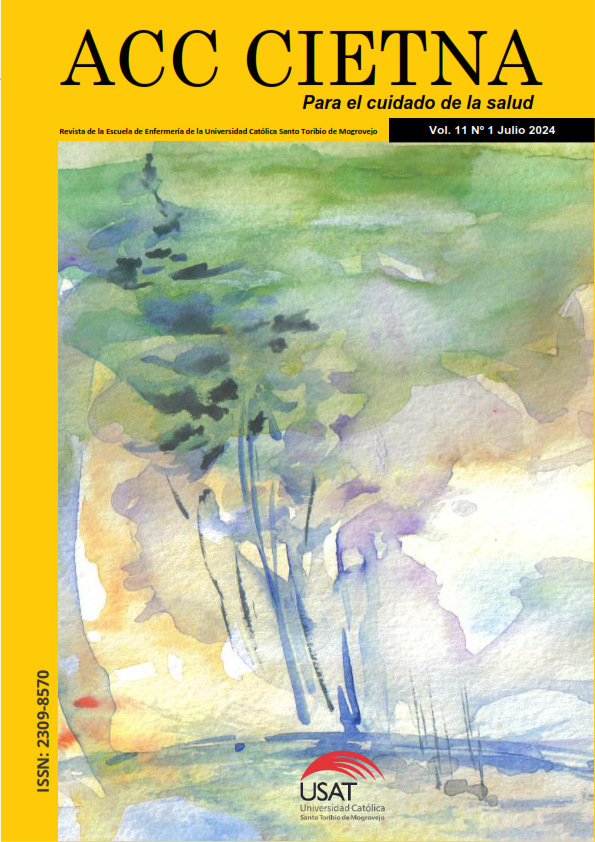Sistemas alternativos y aumentativos de la comunicación en unidades críticas: Una revisión sistemática
Resumen
Objetivo: Identificar la evidencia científica sobre los Sistemas alternativos y aumentativos de la comunicación en las Unidades críticas. Método: Revisión bibliográfica de artículos originales realizada en los meses de abril-setiembre del 2023 en las bases de datos de Medline (Pubmed), Cochrane Library, Scopus, Embase, Biblioteca en Salud (BVS), Web of Science, Science Direct, Scielo y Redalyc utilizando los descriptores de ciencias de la salud (Decs): Enfermero; Enfermería; Enfermería de cuidados críticos; Sistemas de comunicación alternativos y aumentativos; Comunicación; se utilizaron los operadores booleanos AND y OR y se realizaron diferentes combinaciones. Resultados principales: Se identificaron 500 artículos y tras emplear los criterios de inclusión y exclusión, fueron seleccionados 20 estudios originales. Conclusión general: La comunicación con los pacientes está limitada por la condición clínica y dispositivos biomédicos. Los sistemas empleados son Sin ayuda (comunicación verbal, no verbal y escrita) y Con ayuda, de baja tecnología (lápiz y papel, tableros y pictogramas) y alta tecnología (válvulas del habla y Tablet con aplicativos móviles).
Descargas
Citas
Holm A, Viftrup A, Karlsson V, Nikolajsen L, Dreyer P. Strengthening and supporting nurses’ communication with mechanically ventilated patients in the intensive care unit: Development of a communication intervention. Umbrella review. J Adv Nurs [Internet]. 2021 Nov 1 [citado 2023 Nov 15]; 76(11): 2909-2920. Disponible en: https://doi.org/10.1016/j.ijnsa.2021.100025
Granados Ch. Procedimiento operacional estandarizado (POE) de comunicación aumentativa-alternativa para pacientes intubados en UCI [Tesis de especialidad en internet]. 2012 [citado 2023 Nov 24]. 122 p. Disponible en: https://repositorio.unal.edu.co/handle/unal/20688
Castaño ÁMH. Hacerse entender: la experiencia de pacientes sometidos a ventilación mecánica sin efectos de sedación. Investig. Educ. En Enferm. [Internet]. 2008 [citado 2023 Sep 24]; 26(2): 236-42. Disponible en: https://www.redalyc.org/articulo.oa?id=105212447006
Freeman-Sanderson A, Morris K, Elkins M. Characteristics of patient communication and prevalence of communication difficulty in the intensive care unit: An observational study. Aust Crit Care [Internet]. 2019 Sep 1 [citado 2023 Dic 12]; 32(5): 373-7. Disponible en: https://pubmed.ncbi.nlm.nih.gov/30348488/
Thakur P, Venkateshan M, Sharma R, Prakash K. Nurses Communication with Altered Level of Consciousness Patients. Int J Nurs Educ. [Internet]. 2016 Ene 1 [citado 2023 Oct 28]; 8:51. Disponible en: https://bit.ly/3QDiQMP
Ortega-Chacón V, Díaz DM. Strategies and Tools for communicating with patients undergoing invasive mechanical ventilation. Rev Esp Comun EN SALUD [Internet]. 2017 Jun 9 [citado 2023 Jun 10]; 92-100. Disponible en: https://bit.ly/46fDHeO
Wunsch H, Linde-Zwirble WT, Angus DC, Hartman ME, Milbrandt EB, Kahn JM. The epidemiology of mechanical ventilation use in the United States. Crit Care Med. [Internet]. 2010 Oct [citado 2023 Sep 22]; 38(10): 1947. Disponible en: https://doi.org/10.1097/CCM.0b013e3181ef4460
Dithole KS, Thupayagale-Tshweneagae G, Akpor OA, Moleki MM. Communication skills intervention: promoting effective communication between nurses and mechanically ventilated patients. BMC Nurs [Internet]. 2017 Dic 15 [citado 2023 Dic 26]; 16(1): 74. Disponible en: https://bmcnurs.biomedcentral.com/articles/10.1186/s12912-017-0268-5
Schandl A, Falk AC, Frank C. Patient participation in the intensive care unit. Intensive Crit Care Nurs. [Internet]. 2017 Oct 1 [citado 2023 Nov 16]; 42: 105-9. Disponible en: https://doi.org/10.1016/j.iccn.2017.04.006
Handberg C, Voss AK. Implementing augmentative and alternative communication in critical care settings: Perspectives of healthcare professionals. J Clin Nurs. [Internet]. 2018 [citado 2023 Oct 28]; 27(1-2): 102-14. Disponible en: https://doi.org/10.1111/jocn.13851
Zubow L, Hurtig R. A Demographic Study of AAC/AT Needs in Hospitalized Patients. Perspect Augment Altern Commun [Internet]. 2013 Jun [citado 2023 Oct 28]; 22(2): 79-90. Disponible en: https://bit.ly/3G08yRK
Rodriguez CS, Spring HJ, Rowe M. Nurses’ Experiences of Communicating With Hospitalized, Suddenly Speechless Patients. Qual Health Res. [Internet]. 2015 Feb 1 [citado 2023 Oct. 28]; 25(2): 168-78. Disponible en: https://doi.org/10.1177/1049732314550206
Correa P, Correa M, Pérez J. Comunicación aumentativa: una introducción conceptual y práctica. Servicio de Publicaciones [Internet]. 2011 [citado 2023 Nov 16]. Disponible en: https://dialnet.unirioja.es/servlet/libro?codigo=730309
Happ MB, Seaman JB, Nilsen ML, Sciulli A, Tate JA, Saul M, et al. The number of mechanically ventilated ICU patients meeting communication criteria. Heart Lung. [Internet]. 2015 Ene 1 [citado 2023 Nov 18]; 44(1): 45-9. Disponible en: https://doi.org/10.1016/j.hrtlng.2014.08.010
Sánchez LÁQ. Comunicación aumentativa y alternativa como estrategia fonoaudiológica. Areté [Internet]. 2015 Dic 30 [citado 2023 Jul 2]; 15(2): 39-47. Disponible en: https://arete.ibero.edu.co/article/view/1013/802
Flaubert JL, Spicer CM, et al. Augmentative and Alternative Communication and Voice Products and Technologies: The Promise of Assistive Technology to Enhance Activity and Work Participation. National Academies Press [Internet]. 2017 [citado 2023 Nov 24]. Disponible en: https://www.ncbi.nlm.nih.gov/books/NBK453284/
López P. Implementación de un cuaderno de comunicación aumentativa/alternativa basado en las 14 necesidades de Virginia Henderson para pacientes intubados conscientes. [Tesis de grado en internet]. 2019 [citado 2023 Nov 24]. 53 p. Disponible en: https://riull.ull.es/xmlui/handle/915/15130
Ju XX, Yang J, Liu XX. A systematic review on voiceless patients’ willingness to adopt high-technology augmentative and alternative communication in intensive care units. Intensive Crit Care Nurs. [Internet]. 2021 Abr 1 [citado 2023 Jun 3]; 63: 102948. Disponible en: https://doi.org/10.1016/j.iccn.2020.102948
López L, Tarrillo R. Efectividad de los tipos de comunicación en enfermería para mejorar la calidad de asistencia en pacientes con ventilación mecánica invasiva sin sedoanestesia en la unidad cuidados intensivos [Tesis de especialidad en internet]. Perú: Universidad Norbert Wiener; 2020 [citado 2023 Jun 3]. 48 p. Disponible en: https://hdl.handle.net/20.500.13053/3809
Jiménez LMG. Sistemas y Estrategias de Comunicación Aumentativa y Alternativa en Cuidados Intensivos. Areté [Internet]. 2020 Dic 22 [citado 2023 May 11]; 20(2): 83-96. Disponible en: https://arete.ibero.edu.co/article/view/art.20209/1623
Carruthers H, Astin F, Munro W. Which alternative communication methods are effective for voiceless patients in Intensive Care Units? A systematic review. Intensive Crit Care Nurs. [Internet]. 2017 Oct 1 [citado 2023 Ene 14]; 42: 88-96. Disponible en: https://doi.org/10.1016/j.iccn.2017.03.003
Espinoza C, Baeza D, Rivera R, Ceballos V. Comunicación entre paciente adulto críticamente enfermo y el profesional de enfermería: una revisión integrativa. Enferm Cuid Humaniz. [Internet]. 2021 Jun 11 [citado 2023 Mar 16]; 10(1): 30-43. Disponible en: https://doi.org/10.22235/ech.v10i1.2412
Rojas N, Bustamante T, Dois C. Comunicación entre equipo de enfermería y pacientes con ventilación mecánica invasiva en una unidad de paciente crítico. Aquichan [Internet]. 2014 [citado 2023 Abr 18]; 14(2): 184-95. Disponible en: https://doi.org/10.5294/aqui.2014.14.2.5
Patak L, Gawlinski A, Fung NI, Doering L, Berg J. Patients’ reports of health care practitioner interventions that are related to communication during mechanical ventilation. Heart Lung [Internet]. 2004 Sep 1 [citado 2023 Sep 6]; 33(5): 308-20. Disponible en: https://doi.org/10.1016/j.hrtlng.2004.02.002
Rier D. The missing voice of the critically ill: a medical sociologist’s first-person account. Sociol Health Illn [Internet]. 2000 [citado 2023 Abr 13]; 22(1): 68-93. Disponible en: https://bit.ly/3ubX37o
Hurtig RR, Alper RM, Bryant KNT, Davidson KR, Bilskemper C. Improving Patient Safety and Patient-Provider Communication. Perspect ASHA Spec Interest Groups [Internet]. 2019 Oct [citado 2023 Jul 20]; 4(5): 1017-27. Disponible en: https://doi.org/10.1044/2019_persp-19-00134
Otuzoğlu M, Karahan A. Determining the effectiveness of illustrated communication material for communication with intubated patients at an intensive care unit. Int J Nurs Pract. [Internet]. 2014 [citado 2023 Ago 23]; 20(5): 490-8. Disponible en: https://doi.org/10.1111/ijn.12190
Happ MB, Sereika SM, Houze MP, Seaman JB, Tate JA, Nilsen ML, et al. Quality of care and resource use among mechanically ventilated patients before and after an intervention to assist nurse-nonvocal patient communication. Heart Lung [Internet]. 2015 Sep 1 [citado 2023 Jun 3]; 44(5): 408-415. Disponible en: https://doi.org/10.1016/j.hrtlng.2015.07.001
Grant MJ, Booth A. A typology of reviews: an analysis of 14 review types and associated methodologies. Health Inf Libr J. [Internet]. 2009 [citado 2023 Mar 19]; 26(2): 91-108. Disponible en: https://doi.org/10.1016/j.hrtlng.2013.11.010
Rodriguez CS, Rowe M, Thomas L, Shuster J, Koeppel B, Cairns P. Enhancing the communication of suddenly speechles critical care patients. Am J Crit Care. [Internet]. 2016 [citado 2023 Mar 11]; 25(3): 40-7. Disponible en: https://doi.org/10.4037/ajcc2016217
Nilsen ML, Sereika SM, Hoffman LA, Barnato A, Donovan H, Happ MB. Nurse and patient interaction behaviors’ effects on nursing care quality for mechanically ventilated older adults in the ICU. Res Gerontol Nurs. [Internet]. 2014 [citado 2023 Dec 12]; 7(3): 113-25. Disponible en: https://doi.org/10.3928/19404921-20140127-02
Koszalinski RS, Tappen RM, Melhuish T, Grumme V. Evaluation of a Novel Communication Application From Nurses’ Perspectives. Comput Inf Nurs. [Internet]. 2017 [citado 2023 Ago 22]; 35(6): 300-6. Disponible en: https://sci-hub.st/10.1097/CIN.0000000000000322
Koszalinski RS, Tappen RM, Hickman C, Melhuish T. Communication Needs of Critical Care Patients Who Are Voiceless. Comput Inf Nurs [Internet]. 2016 Jun [citado 2023 Sep 26]; 34(8): 339-44. Disponible en: https://doi.org/10.1097/cin.0000000000000266
Koszalinski RS, Tappen RM, Viggiano D. Evaluation of Speak for Myself with Patients Who Are Voiceless. Rehabil Nurs. [Internet]. 2015 [citado 2023 Abr 16]; 40(4): 235-42. Disponible en: https://sci-hub.hkvisa.net/10.1002/rnj.186
Goldberg M. Design and Testing of a Novel Communication System for Non-Vocal Critical Care Patients With Limited Manual Dexterity [Tesis de doctorado en internet]. 2020 [citado 2023 Oct 14]. 79 p. Disponible en: https://repository.escholarship.umassmed.edu/handle/20.500.14038/31321
El-Soussi AH, Elshafey MM, Othman SY, Abd-Elkader FA. Augmented alternative communication methods in intubated COPD patients: Does it make difference. Egypt J Chest Dis Tuberc. [Internet]. 2015 Ene 1 [citado 2023 Dic 26]; 64(1): 21-8. Disponible en: https://doi.org/10.1016/j.ejcdt.2014.07.006
Happ MB, Garrett KL, Tate JA, DiVirgilio D, Houze MP, Demirci JR, et al. Effect of a multi-level intervention on nurse–patient communication in the intensive care unit: Results of the SPEACS trial. Heart Lung [Internet]. 2014 Mar 1 [citado 2023 Jul 21]; 43(2): 89-98. Disponible en: https://doi.org/10.1016/j.hrtlng.2013.11.010
Gropp M, Johnson E, Bornman J, Koul R. Nurses’ perspectives about communication with patients in an intensive care setting using a communication board: A pilot study. Health SA Gesondheid [Internet]. 2019 [citado 2023 Nov 18]; 24: 1-9. Disponible en: https://doi.org/10.4102/hsag.v24i0.1162
Momennasab M, Ardakani MS, Rad FD, Dokoohaki R, Dakhesh R, Jaberi A. Quality of Nurses’ Communication with Mechanically Ventilated Patients in a Cardiac Surgery Intensive Care Unit. Investig Educ. En Enferm [Internet]. 2019 Feb 11 [citado 2023 Oct 6]; 37(2). Disponible en: https://www.redalyc.org/journal/1052/105260696002/
Saldaña DMA, Alarcón MP, Romero HA. Aspects that facilitate or interfere in the communication process between nursing professionals and patients in critical state. Investig. Educ. En Enferm. [Internet]. 2015 [citado 2023 Nov 6]; 33(1): 102-11. Disponible en: http://www.redalyc.org/articulo.oa?id=105238622012
Flinterud SI, Andershed B. Transitions in the communication experiences of tracheostomised patients in intensive care: A qualitative descriptive study. J Clin Nurs. [Internet]. 2015 [citado 2023 Jul 22]; 24(15-16): 2295-304. Disponible en: https://bit.ly/3FXcenE
Mobasheri MH, King D, Judge S, Arshad F, Larsen M, Safarfashandi Z, et al. Communication aid requirements of intensive care unit patients with transient speech loss. Augment Altern Commun. [Internet]. 2016 Nov [citado 2023 Jun 18]; 32(4): 261-71. Disponible en: https://doi.org/10.1080/07434618.2016.1235610
Derechos de autor 2024 Katherine Lluliana Iparraguirre Vargas

Esta obra está bajo licencia internacional Creative Commons Reconocimiento 4.0.
Los autores conservan los derechos de autor.
Esta obra está bajo una licencia internacional Creative Commons Attribution 4.0.
Los artículos publicados por la revista científica "Acc Cietna: para el cuidado de la salud" de la Escuela de Enfermería de la Universidad Católica Santo Toribio de Mogrovejo, Chiclayo, Perú están sujetos a una licencia internacional Creative Commons Attribution CC BY 4.0.




















 BIBLIOTECA USAT
BIBLIOTECA USAT